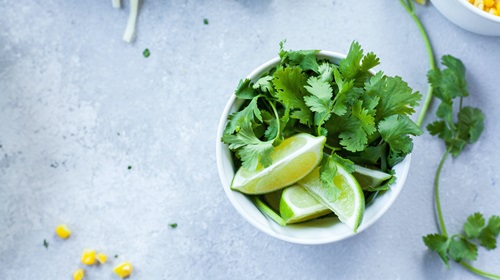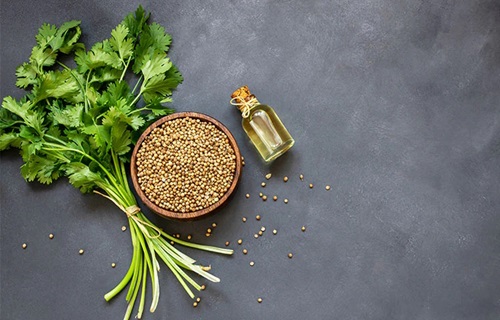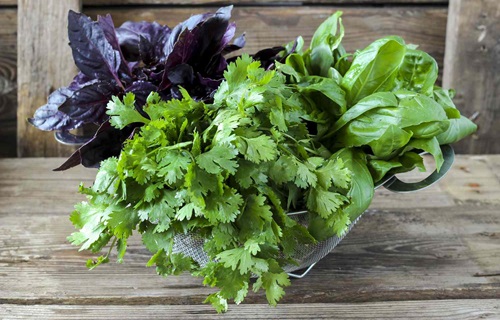Oct 3rd 2024
How To Grow Cilantro Indoors
Cilantro isn’t just a delightful addition to your favorite dishes but a fantastic herb to grow indoors! This vibrant green plant is loved in many cuisines worldwide, bringing a fresh, zesty kick to everything from tacos to salads.
Growing cilantro indoors means you can enjoy its vibrant flavor year-round right in your kitchen. Plus, snipping a few leaves from your plant while cooking is super rewarding!
Hydroponic towers are an excellent choice for growing cilantro for those looking to take their indoor gardening to the next level. The ALTO Garden GX Hydroponic Tower is designed with an efficient system that promotes optimal growth and yields vibrant, fresh herbs.
This guide will explore the ins and outs of cultivating cilantro indoors. We’ll cover simple steps to ensure your plant thrives and share some tips on making the most of your harvest.
Why Grow Cilantro Indoors?
Growing cilantro indoors isn’t just about adding a splash of greenery to your kitchen; it has many benefits!

First off, having fresh herbs at your fingertips means you can elevate your cooking any day of the week. Imagine snipping a handful of cilantro just moments before you sprinkle it into your favorite dishes. Say goodbye to store-bought herbs that lose their flavor over time—your homegrown cilantro bursts with vibrant taste every time.
Indoor gardening is a fantastic way to keep versatility in your meals. It’s not only about enhancing flavors; it’s about convenience, too! You’ll have easy access to fresh herbs whenever you need them, whether you’re whipping up a quick salsa or a fragrant curry.
Plus, cilantro is a low-maintenance plant, making it perfect for beginners or those with a busy lifestyle. With just a bit of care, you can enjoy a steady supply of this zesty herb while reaping the rewards of indoor gardening.
Choosing the Right Cilantro Variety
When it comes to growing cilantro indoors, picking the right variety is key. Different types of cilantro vary in taste, aroma, and even growth habits. Here’s a quick overview of some popular varieties:
Explanation of Different Cilantro Varieties
- Common Cilantro (Coriandrum sativum): The classic choice for culinary uses, offering that iconic fresh flavor.
- Slow Bolt Cilantro: This type resists bolting and is excellent for extending your harvest.
- Vietnamese Coriander (Persicaria odorata): Not true cilantro, but it has a similar taste with a bit more spice—great for Asian dishes.
- Dwarf Cilantro: This compact variety is perfect for small spaces and ideal for windowsills or pots.
Best Varieties for Indoor Growth
For indoor gardening, it’s crucial to choose varieties that flourish in containers and under limited light. Here are the best picks:
- Common Cilantro: Its robust growth and easy maintenance make it a go-to for home cooks.
- Slow Bolt Cilantro: This one's a must-have for those who want a longer growing season without the worry of premature blooming.
- Dwarf Cilantro: Perfect for those tight kitchens, it adds green without taking up too much space.
Preparing Your Growing Space
Creating the perfect environment for your cilantro is key to healthy plants and a bountiful harvest. Let’s dive into some tips to help your cilantro thrive!
Optimal Indoor Conditions: Cilantro loves bright, indirect light, so find a spot where it can soak up at least six hours of light daily If natural light is scarce, consider using grow lights to give your plants the boost they need.
Temperature Matters: Cilantro prefers a cool to moderate climate, ideally between 60°F and 75°F. Be sure to keep your plants away from heat sources or drafty windows, as these fluctuations can stress them out.
Humidity is Key: Don’t underestimate the importance of humidity! Cilantro thrives in slightly humid environments. If the air in your home is dry, try misting your plants occasionally or using a humidity tray to keep them happy.
Choosing the Right Location for Your Cilantro
Now, where you place your cilantro is just as important as the conditions you create. A sunny windowsill can be a great spot, but make sure it doesn’t get too hot during the day. If you're short on space, consider using hanging pots or vertical gardens—they can work wonders!
Find that sweet spot where your plants can thrive without being overcrowded or overlooked.
Importance of a Well-Ventilated Space
Finally, don’t underestimate the importance of good air circulation. A well-ventilated space is crucial for preventing fungal diseases and keeping your plants healthy.
If you want to learn more about the best vegetables to grow hydroponically, check out our Best Vegetables to Grow Hydroponically guide.
Simple solutions like opening a window or using an oscillating fan can gently circulate the air around your cilantro.
With all these aspects in check, you'll be well on your way to cultivating a vibrant indoor cilantro garden that bursts with flavor and freshness!
Selecting the Right Containers and Soil for Growing Cilantro
Growing cilantro indoors can be so rewarding! Choosing the perfect container and soil is crucial to ensure your plants thrive.
Choose the right pot size—aim for something that’s at least 6 to 8 inches deep. This depth allows your cilantro’s roots to spread out, giving them enough space to establish a strong foundation. For material, terracotta pots are a solid choice because they’re breathable and help prevent overwatering. If you prefer something lighter, plastic or metal pots can also work if they have good drainage.
While traditional pots are great, hydroponic towers are an innovative alternative. These systems save space and provide a controlled environment for optimal growth, making them ideal for indoor gardening.
With the right setup, whether it's traditional pots or hydroponic towers, you’ll be on your way to enjoying fresh cilantro right from your home!
Soil Requirements
Now, let’s talk about the soil. Cilantro thrives in well-draining soil that's rich in organic matter. A good potting mix will help retain water while ensuring that excess moisture drains away. To enhance your soil, consider adding compost or perlite. Both these elements can enhance air circulation and nutrient access, fostering a flourishing environment for your herbs.
Ultimately, it’s all about combining the right elements to nurture those vibrant green leaves. Happy gardening!
Importance of Drainage Holes
Don’t overlook the importance of drainage holes! These simple openings at the bottom of your containers are crucial for preventing water from accumulating, which can lead to root rot—a gardener’s nightmare. If you’re using a pot without drainage, consider creating a layer of gravel at the bottom to help with water flow.
With the right containers, whether traditional or hydroponic, and the proper soil mix, along with those essential drainage holes, you’ll set your cilantro up for success, giving it the best chance to flourish and grace your dishes with its zest.
Hydroponic Gardening
Hydroponic towers are a fantastic option for growing cilantro. One standout choice is the ALTO Garden GX Hydroponic Tower. This tower is designed with an efficient system that promotes optimal growth, ensuring you get vibrant, fresh herbs right at home. What’s great is that you can grow cilantro without soil, using nutrient-rich water that circulates through the roots.
Plus, the ALTO tower comes equipped with grow lights, so your cilantro gets the ideal light conditions, even if your space is a bit dim.
Learn more about hydroponic gardening by checking out our article on vertical farming at home!
Planting Cilantro Seeds

Planting cilantro seeds can be rewarding and straightforward, especially if you’re venturing into hydroponics. Start by choosing fresh, high-quality seeds for the best results. You’ll want to sow them in a nutrient-rich medium. In a hydroponic setup, a mixture of clay pebbles or rockwool works wonders, allowing ample water flow while providing stability for the roots.
Our ALTO Garden GX Hydroponic Tower includes rockwool cubes, perfect for supporting your cilantro seeds. These cubes provide excellent moisture retention while ensuring adequate airflow, creating an ideal seed germination and root development environment. Using rockwool enhances your hydroponic gardening experience, allowing your cilantro to establish strong roots and thrive in nutrient-rich water.
A Step-by-Step Guide to Germinating and Planting Seeds in the ALTO Garden GX Hydroponic Tower
- Begin by preparing the rockwool cubes included with your ALTO Garden GX Hydroponic Tower by soaking them in water for 5 to 10 minutes to ensure they are adequately hydrated. Watch the video on our germination page for a demonstration.
- Once soaked, drain the cubes in your sink for 10 minutes. Just place them at the bottom of the sink and they will drain by themselves.
- Insert one or two cilantro seeds into the pre-made hole in each Rockwool cube. Try aiming for a depth of around 1/4 inch to help those seeds sprout properly.
- Wait for the seeds to sprout. Be sure your cubes stay moist 24 hours a day. Cilantro takes 1 - 3 weeks to germinate.
- Once your seeds have germinated and are ready for transfer, place the rockwool cubes into the designated slots within the hydroponic tower, ensuring they fit securely.
- Set the grow lights to the recommended schedule, giving your seeds 12-16 hours of light each day to promote healthy growth.
- Keep an eye on the water levels in your hydroponic reservoir and top up when needed.
- Monitor your cilantro seedlings closely, adjusting the light and nutrient levels according to their growth stage for optimal results.
Ensuring Proper Lighting
Importance of Light for Cilantro Growth
Light is essential for growing healthy cilantro—it affects everything from how the leaves develop to the overall vitality of the plant. Without enough light, your cilantro can end up leggy and weak, making it hard to thrive.
Generally, cilantro loves bright, indirect sunlight, and getting that balance just right can really enhance both its health and flavor. So, give your cilantro the light it craves, and you’ll be rewarded with a vibrant herb!
Natural Light vs. Grow Lights
While natural light is excellent, many gardeners grapple with inconsistent sunlight, especially in the winter months. In such cases, supplementary grow lights can be a game changer. They offer controlled, optimal conditions that coax your cilantro to flourish regardless of the season. If you're considering this route, select a light spectrum mimicking natural sunlight.
Tips for Positioning Plants for Optimal Light Exposure
- Position cilantro near a sunny window for at least six hours of sunlight daily.
- If using the ALTO Garden GX Tower, use the included grow LED lights.
- Arrange your lighting setup thoughtfully to optimize growth.
- Monitor and adjust conditions to ensure cilantro thrives in the right environment.
Harvesting Cilantro
Harvesting cilantro is all about timing! The best moment to start snipping those tasty leaves is when your plants are around 9 - 12 inches tall. That’s when they’re at their freshest and packed with flavor!

Remember to trim the outer leaves first to help the inner ones thrive. By doing this, you’re not just enjoying a delicious harvest now, but you’re also promoting new growth and keeping your plant healthy for future snips.
To prolong your harvest period, consider these simple tips:
- Always use clean scissors or shears to prevent any transmission of diseases.
- Don’t take more than a third of the plant at once; this gives it a chance to bounce back quickly.
- Water your cilantro well a day before harvesting to keep it hydrated and happy.
Best Practices for Using and Storing Harvested Cilantro
After you've harvested your cilantro, the key is to keep that fresh flavor alive! Like flowers, you can store fresh cilantro in a glass of water—simply cover the leaves loosely with a plastic bag and pop it in the fridge. This trick helps the leaves stay crisp for a longer time.
If you want to save it for later, try chopping it up and freezing it in ice cube trays with a bit of water or oil. This way, you’ll have convenient portions ready to throw into your dishes whenever inspiration strikes.
Troubleshooting Common Issues
Even the most experienced gardeners face challenges, and cilantro is no exception. If you notice your cilantro leaves turning yellow, it’s a sign that something might be wrong. Yellowing is frequently caused by inadequate nutrients. If the entire leaves turn yellow - it is likely a lack of nitrogen. If the edges of the leaves turn yellow but the rest of the leaf stays green - try adding a bit more potassium.
On the flip side, if your cilantro appears stunted or leggy, it may need more sunlight. Simply moving it to a brighter spot can help it thrive!
Pests can also become a nuisance in your cilantro patch. Aphids particularly love these delicate leaves, which can cause distortion and wilting. If you spot them, don’t worry! A gentle spray of soapy water can help dislodge these pesky pests. Alternatively, consider introducing beneficial insects like ladybugs, which naturally feed on aphids.
Troubleshooting Common Issues in Hydroponic Gardening
Here are some common issues to watch for in hydroponic gardening, along with tips to address them:
- Nutrient Deficiency: Signs include yellowing leaves or stunted growth. Ensure you are supplying a balanced nutrient solution, and consider conducting a nutrient test to diagnose any deficiencies.
- pH Imbalance: If your plants show poor growth or nutrient burn, check the pH level of your nutrient solution with our pH pen. Ideally, it should be between 5.5 and 6.5 for most plants. Adjust as necessary using pH up or down solutions.
- Root Rot: If you catch a bad smell or see roots turning brown, it could be root rot due to watering too much or not enough oxygen. Ensure your system has adequate aeration, and consider using beneficial microbes to combat pathogens.
- Algae Growth: Algae flourish in warm, dimly lit areas, competing for nutrients. Combat this issue by covering your growing containers with opaque materials and ensuring adequate circulation.
- Pests: Common pests include spider mites and whiteflies. To manage infestations effectively, regularly inspect plants and use organic insecticidal soap or neem oil.
Key Takeaways
- Grow cilantro indoors for fresh herbs year-round.
- Choose the right variety suited for indoor growth.
- Ensure good ventilation and avoid overcrowding.
- Provide proper lighting, such as a sunny window or grow lights.
- Regularly harvest to promote continuous growth and flavor.
- Troubleshoot promptly for issues like pests or nutrient deficiencies.
- With patience and care, your indoor herb garden can thrive.
Limited Time Offer: $10 Off + Free Starter Bundle
For a limited time, when you purchase any ALTO Garden Tower, you’ll snag a $10 discount and a Free Starter Bundle designed to kickstart your soilless gardening adventure! This bundle is packed with essential tools and nutrients to help you maximize the potential of your system right from the get-go. All you have to do is enter your email address to claim your coupon, and you’ll be well on your way to creating a lush indoor garden.
Don’t let this opportunity pass you by—transform your living space into a thriving oasis where fresh herbs and vegetables flourish.
Ready to stay in the loop? Sign up for our newsletters for the latest updates, tips, and exclusive offers tailored to your hydroponic and aeroponic gardening needs. Plus, be sure to check out our ALTO Garden GX Hydroponic Tower - it might be the perfect addition to your home!




